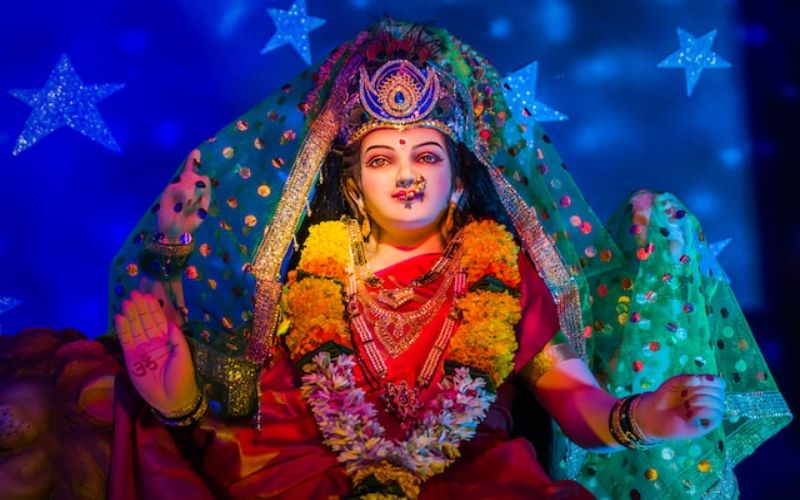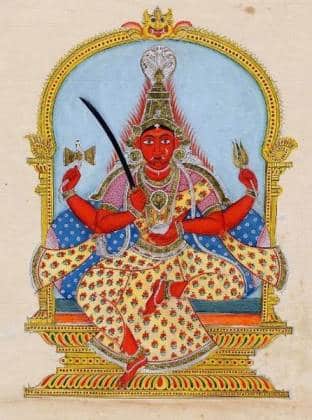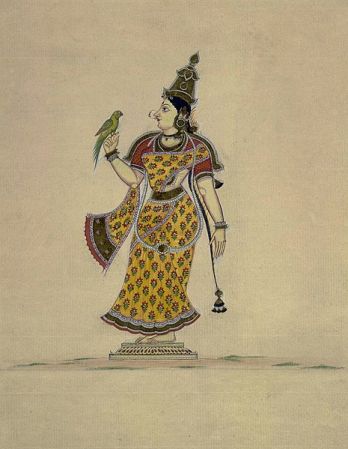Hinduism, the world’s third-largest religion, is a way of life by which its followers abide. Central to the Hindu faith is the doctrines of Samsara (the continuous cycle of life and death) and Karma (the universal law of cause and effect ).
Reincarnation is at the core of Hinduism
For Hindus, the belief in reincarnation is core to their choices and way of life. This endless cycle is central to samsara, the “wheel of life” or “wheel of time” that we all exist in. One of the key concepts of Hinduism is “Atma,” i.e., the soul.
According to this, every living being has a soul, and they all are part of the Supreme Soul. One can say that God resides in oneself because all souls converge with Him. It is the power that upholds and supports everything.
According to Hindu belief, after death, a soul is carried into a new physical body, which can be a human, animal, or even a divine body. Following that belief, a soul is something indestructible. Because samsara is another chance to have a life, doing good deeds is considered essential to leading the present life.
Therefore, according to Hindu philosophy, death is not the end of life. Instead it is just apart of an endless journey. The consciousness is carried along with the soul, imprinted by all the deeds done in this birth. And the soul grows closer to perfection with each birth. To get a good life next, the present life should be filled with good karma. This ultimately results in peace within the soul.
Karma decides your fate
The samsara cycle is continuous because of karma. Liberation from this cycle (moksha) is the ultimate goal of every being. This can only be achieved by attaining and practicing good karma. Heaven, according to this concept, is a place where all the souls are released after obtaining moksha.
Karma can be created from an individual’s actions, thoughts, words, attitudes, and lifestyle. According to common Hindu belief, a person can create his or her own karma by following some simple rules. This process includes rules such as loving and forgiving oneself and others, practicing kindness and compassion and reflecting on one’s roles and actions.
Although not as many people believe in reincarnation today, they still believe in good and bad karma affecting their lives. This karma is said to pass down through generations. They believe in balance and one can reap what one sows. If you have taken something from anyone, something will be taken away from you. If you have donated something, your health and wealth will increase.
From this concept, arises the idea of penance. Penance for your sins is considered good because it brings God’s blessings and thus smoothes out your karma. But people realize that this is not an easy task. They understand that they must gain a wide range of experiences in order to reach the required level of maturity.
The concepts of samsara, karma, and moksha bring inner peace and self-assurance to every Hindu’s life. They know that everything happens for a reason. Also, they know that they will be given a chance to rectify their mistakes and carry on with more good work.
The Hindu gods and goddesses
In Hinduism, there are varied and diverse schools of philosophies, traditions, and rituals that can be seen across the whole Indian subcontinent and other countries of Southeast Asia. Gods and goddesses are venerated in different forms. But most individual worshippers are primarily devoted to a single god or goddess. The most popular among the Hindu gods are Shiva, Vishnu, Ganesh, and a number of the goddesses.
The worship of various deities who were personifications of nature started in the Stone Age. Earth, being the primary source of food, was the first to be personified. It was often equated with the womb of a woman.
There are many wall paintings of women with tree branches coming out of them, which symbolize the fertility of the earth. Water and trees began to reverberate as well. Some of the oldest goddesses are shown as crude statues. They are often shown covered in turmeric and having silver eyes.
The Hindu goddesses of the Indus Valley civilization (c. 3300–c. 1300 BCE) were identified as Kuladevis and Gramadevis, i.e., clan and settlement goddesses, and they are still part of many traditions across India. The Hindu goddesses, in their different manifestations, are envisioned as patrons of art, culture, joy, spirituality, and liberation.
Early goddesses mentioned in the Rig veda
Many primitive Hindu goddesses are mentioned in the Rig Veda. They are referred to as Usha (the goddess of dawn), Aranyani (the goddess of forests), and Vak (the goddess of speech). Goddesses like Durga, Kali, and Shri, which represent power and strength, are just conceptual at this time. At this time the only form of power is Yakshi , wife of Yaksha. She is considered to have a ferocious spirit. But her worship is not widely spread.
As the goddesses evolved over time, many mythological stories started to be associated with them. They now show the complexity of society, traditions, and human nature. For example, now they were two- or four-armed and fully grown women. Now, kings have Durgs (forts), so the Hindu goddess Durga was the one who protected their forts. Kings worshiped her for power and success and offered her the blood of their enemies. They started to show every aspect of life, whether it was wealth, art, music, or motherhood.
Although, in the starting the goddesses were personifications of natural feminine elements and independent in their forms but with time they were shown with their consorts. They were linked to either Lord Vishnu or Lord Shiva. However, in some mythology legends, the goddesses are the main characters.
They are the ones who command the male gods to do the work of creation and destruction. As a metaphor, the female goddesses embody matter and hence nature. They have connections with agriculture, fertility, and vegetative life. Also, there are other associations, such as with earth, rain, the rising sun, and night. They are associated with a whole range of aspects of womanhood.
Asura – Symbol of Evil
Asuras, in Hinduism, are powerful demi-gods. Some of them are good but mostly they are associated with bad qualities. The good asuras are called Adityas and the bad ones are known as Danavas. They basically show the good and bad intentions or qualities of humans. They represent the dualism of everything in the universe.
Asura means departed soul. They are now considered chaos-creating creatures that were initially good but over time vices overpowered them. They became evil and had to be destroyed as they started threatening the gods. Eventually becoming proud and starting to violate sacred laws.
According to Hindu mythology, each asura and deva emerged from the same father. They share the same residence and have potential and knowledge. But what differentiates both of them are their actions, intentions and choices they make.
Asuras are shown in constant battle with the gods. Their battle symbolizes creation and destruction. They symbolize the power tussle between good and bad. And as good always prevails, so in every battle they fight, gods always win. Even if gods can’t defeat them, there are goddesses who become the conquerors of evil. We know the story, of how Parvati in the form of Durga and Kali slays demons that destroy universal order, create chaos and harm human beings.
List of The Major Hindu Goddesses
Tridevi
Tridevi means three goddesses. In Hinduism, the Tridevis are Saraswati, Lakshmi and Parvati. They are feminine manifestations of Trimurti (the great Trinity), their consorts Brahma, Vishnu and Shiva.
Tridevi in Hinduism are the manifestations of Adi Shakti, the supreme being. They are considered as the divine mother of all. They are the goddesses with roles of creator, preserver and destroyer. The Tridevi along with their masculine counterpart, the Trimurti, symbolizes the core concept of Hinduism. They represent the cyclical nature of first birth, then preservation and destruction and finally subsequent rebirth.
Saraswati
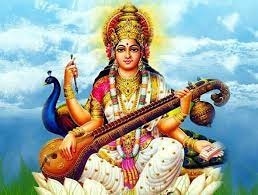
“Sara” means essence, and “Sva” means self. So, Saraswati is she who helps realize the essence of self. She is the Hindu goddess of knowledge, music, art, wisdom, and learning.
She is generally depicted as having four arms and celebrated as a goddess with healing and purifying powers. In the Upanishads, she is invoked to remind the reader to meditate on virtue as well as the meaning of one’s actions. According to mythology, Saraswati was born from the mind of Brahma, and Brahma ordained that she should stay on the tip of everybody’s tongue.
A hamsa (swan) is often shown near her feet. According to Hindu mythology, the hamsa is a sacred bull and if offered a mixture of milk and water, is said to be able to drink the milk alone. Thus symbolizing the ability to discriminate between good and evil. Sometimes a peacock (the devourer of snakes) is shown, which symbolizes the ability to transmute the serpentine nature of oneself into enlightenment.
She is a wonderful source of strength for all who seek to learn and ollow a spiritual path as well as discover the truth and higher wisdom.
Lakshmi
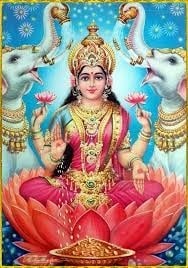
Lakshmi is the goddess of wealth and good fortune. As the wife of Vishnu, she takes different forms in order to be with him in each of his incarnations. For example, when he was the dwarf Vamana, she appeared from the lotus and was known as “Padma,”, when he was king Rama, she was his queen Sita and when he is Lord Krishna, she is Radha. So, she is inseparable from him, just as speech is from meaning, knowledge is from intellect, and good deeds are from righteousness.
In one of her births, she was born out of the ocean of milk at the time of its churning. She is often represented as seated on a lotus, full-breasted, broad-hipped, smiling, and sometimes with a pair of elephants pouring water over her and represents all that is feminine.
Lakshmi has many forms such as when she is pictured as having a dark complexion, she is the consort of Vishnu. However if she is a golden yellow, she is the source of all wealth. Finally if she is white, she is the purest form of Prakrit (nature), from which the universe has developed, and the pink complexion reflects her compassion. These are all forms of Lakshmi as Ashta-Lakshmi.
The famous festival of Diwali is celebrated in her honor, which spiritually signifies the victory of light over darkness, knowledge over ignorance, and hope over despair. It is believed that Lakshmi goes only to those houses where people are clean and hardworking.
Parvati

Parvati is the second wife of the Hindu god Shiva and the reincarnation of his first wife, Sati, who immolated herself during the yajna (fire sacrifice). She is always depicted as a mature and beautiful woman. She is the goddess of love, marriage, children, devotion, fertility, and beauty.
In Hinduism, she is the goddess who carries the divine energy between a man and a woman. Through her many forms, she displays the full range of what women can do in society. She is never confined by social expectations to conform to a single image of femininity. One of her forms is Durga, the warrior and protector goddess who rides a ferocious tiger and destroys evil.
In her other form, Kali, she is the creator and destroyer goddess. Her blood-soaked sword cuts the bonds of ignorance and ego. In this form, she represents the time before the world existed, when all was black. Her unbraided mane speaks to her freedom from society’s bondage.
Apart from these, she forms Kamakshi ( a love goddess) and Annapurna ( the goddess of abundance). Thus, she is everywhere – an omnipresent mother watching over her children.
More on these manifestations can be read below.
Durga
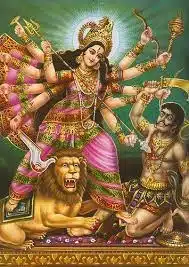
In Sanskrit, Durga means “the inaccessible” or “invincible.” In Hinduism, she is also known as Devi or Shakti and was created to slay the buffalo demon Mahishasura by the Trinity and other lesser gods. Their trust helped her to overcome the demon, thus giving the message that if women are surrounded by people who are positive and encouraging, there is no limit to the heights a woman can reach.
According to myth she was born fully grown, presenting a fierce form to her enemies. She combats evil that threatens peace, prosperity, and dharma. She unleashes her divine wrath against the wicked for the liberation of the oppressed.
So, she is both destructive and benevolent as the need arises. She is powerful yet grounded, determined and dedicated, strong, fearless, and emotionally intelligent.
Durga is considered the feminine epitome of strength and takes many forms to restore peace and order. Her story is significant as it reminds us of the boundless power and tenacity of a woman. She symbolizes a woman with an unstoppable force, whose skills and power are developed and nurtured.
Kali

Goddess Kali, also known as Kalika or Mahakali, is considered to be the goddess of ultimate power. Her abode is said to be at the cremation grounds. She is worshiped by many Tantric sects as the divine mother of the universe and as the principal energy.
Goddess Kali is the feminine form of time and symbolizes changing aspects of nature. She is often portrayed as black in complexion but sometimes as blue in popular Indian art. Her eyes are portrayed as being filled with rage. Sometimes she also wears a skirt made of human arms and a garland of human heads.
She is also often depicted naked, which symbolizes her being beyond the covering of Maya. So she is pure and has no permanent qualities, and she will continue to exist even when the universe ends.
Goddess Kali is often pictured with an extended tongue. This supposedly indicates her embarrassment over the sudden realization that she has stepped on her husband’s chest. She is often associated with sexuality and violence but is also considered a strong mother figure.
Kamakshi
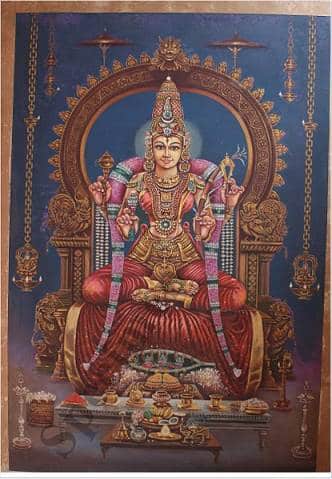
Kamakshi is the goddess of beauty and love. The meaning of her name is “the desirable one” or “one whose eyes are full of desire.” She is associated with attraction and charisma. She is the manifestation of the goddess Parvati and is also known as Kamakhya.
According to legend, Lord Shiva once opened his third eye to destroy Kama (the god of love). But instead of being annihilated, he became an asura. And goddess Parvati slayed this asura. As she killed the asura that emerged from the ashes of Lord Kama, she is known as Kamakashi in this form.
She symbolizes the sovereignty of nature. She blesses her devotees with wisdom, success, and fame. Also, devotees are blessed with peace, grace, and abundance.
Annapurna
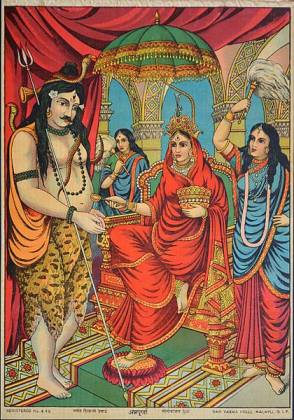
Annapurna is the goddess of abundant food and nourishment. Food is considered sacred in Hinduism, as worship of any god or goddess starts with offering food. So, she is an important goddess. She is also known by other names such as Bhuvanesvari (the goddess of earth), Renu (the goddess of atoms), or Annada (the donor of food).
She is often depicted as a young goddess with a red complexion and three eyes. Her one hand has a bowl full of porridge, while her other hand has a golden ladle decorated with jewels. She is shown seated on a throne with the crescent moon on her head. Lord Shiva is shown standing to her right with a begging bowl.
This is according to a story where, due to some miracle of Parvati, the whole world was out of food. So, Lord Shiva was begging for food for his children. And goddess Parvati, in the form of Annapurna, offered him food. After that, Lord Shiva built a temple in her honor.
Ganga
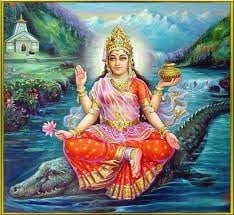
Goddess Ganga is the personification of the river Ganga and symbolizes purification and forgiveness. She is considered the mother of humanity. Worshippers immerse the ashes of their kin in the river Ganga so that their souls can be brought closer to moksha ( liberation from the cycle of life and death)
She is considered to have descended to earth, which occurred because of a sage named Bhagiratha, aided by the god Shiva, who agreed to hold Ganga in his matted locks and release her with reduced force. This symbolizes that if we can control the descent of our thoughts themselves and regulate their flow through our present, then we can too watch our full potential as we move from our source to the eternal ocean of liberation.
Chandi
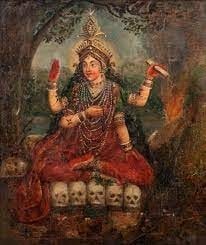
Chandi is another form of Durga, but one who is more powerful and is manifested to destroy evil. She is also referred to as the “fierce power of anger” of Brahman. She is the passionate one.
As Chandi, she can be invoked for removing obstacles and allowing us to attain Purusharthas (the four goals of human life). She embodies the three qualities of nature: creation, preservation, and finally transformation.
With her golden body blazing with the splendor of a thousand suns, seated on her lion, she is one of the most wonderful of all personifications of cosmic energy. Her name means “she who tears apart thought” and she tears apart our thoughts that feed the ego and that take us off our path. She helps us find balance in our lives.
Bhumi
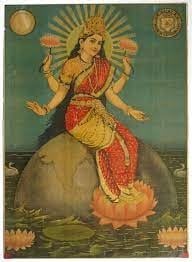
Goddess Bhumi is the personification of the earth. She is depicted as being seated on a platform that rests on the backs of four elephants, representing the four cardinal directions. Goddess Bhumi not only gives us life but also nourishes and sustains us.
She is the second aspect of Vishnu’s consort Lakshmi and also the mother of the goddess Sita. After Sita leaves her husband, Lord Rama, the earth opens up and enfolds Sita in her lap.
In Hinduism, respecting and honoring the goddess Bhumi can be done through mantras. And also through action by living mindfully and respectfully of the impact we have on Earth and the environment.
Gayatri
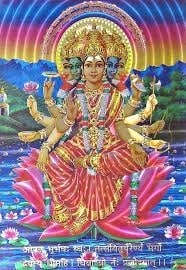
Goddess Gayatri is the personified form of Gayatri Mantra, which is a popular hymn from Vedic texts. It is translated as “May the Almighty God illuminate our intellect to lead us along the righteous path.”
She is sometimes identified as the feminine form of Gayatri (the Hindu solar god). She is typically portrayed with five faces and mounted on a lotus flower. The five faces symbolize five elements of the universe, i.e., the earth, the water, the fire, the air, and the sky.
Green Tara
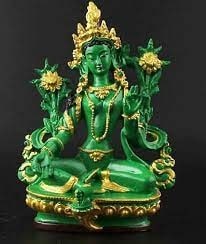
Tara means star in Sanskrit. She is considered the goddess who has the ability to guide her followers on their spiritual paths. She is mostly worshiped in Buddhist traditions and offers a sense of inclusivity to many female practitioners.
According to Himalayan traditions, she is depicted in five different colors with the common being green, which is associated with enlightened activity, and active passion. Another common color is White Tara, associated with maternal compassion and healing.
She is known as the “mother of liberation” and represents the virtues of success in work and achievements. She is also associated with the wind element, which signifies that she is swift in responding to calls for aid.
Regional deities
Yakshi

Goddess Yakshi, or Yakshini, represents a group of feminine natural spirits. Yakshi and her husband are associated with sacred groves worshiped across India. They are considered attendees of Kubera (treasurer of the gods). Because of this they are the guardians of the treasure of the gods, which is supposed to be hidden in the earth.
According to Hindu mythology, it was a common belief that benevolent spirits would bring food, health, and fertility. But there are also many evil forms of Yakshi that can haunt and curse humans. There are about 36 Yakshinis in mythology. According to many folklore stories, murdered women can be reborn as vengeful yakshas.
According to prevailing beliefs, Yakshinis are considered family deities. They are usually placed in a corner spot, especially where grains are stored. It is said that ancestors who died protecting the family became Yakshinis. As a result of their abilities, they protect family and family wealth.
Mariamman
Mariamann is the Hindu goddess of the rain. She is mostly worshiped in rural areas of south India. She is also sometimes associated with other goddesses such as Parvati, Kali, Durga, Sita, or Shitla.
According to legends, she was the wife of sage Jamadagni. She was famous for her devotion and chastity. Her devotion was in fact so powerful that she could draw water even from unbaked pots.
As rain brings a good harvest, she is also the goddess of prosperity. She is often depicted as a beautiful young woman with a red face and wearing a red dress. She often holds a trident in one hand and a bowl in the other. Sometimes, however she is shown with two attitudes. One shows her pleasant nature, and the other shows her terrifying demeanor.
Minakshi
Minakshi means “fish-eyed.” So she is considered a mother with fish eyes. It is said that fish never close their eyes, and similarly, the goddess never closes her eyes and always watches over her devotees. Her eyes are also said to give life to the unborn.
Goddess Minakshi is thought to be a manifestation of the goddess Parvati. Her consort is Sundareswarar, who is a form of Lord Shiva. According to legend, she was born a princess with three breasts. Lord Shiva told her parents that they should treat her well and that her true form would be revealed at the right time. Finally, she met with Sundareswarar and revealed her true form as Minakshi. She lost her third breast and became the consort of Lord Shiva.
She is often depicted with a small dagger on her waist. A parrot can be seen near her, which symbolizes Kama (the god of love). Her temple has paintings of her marriage. In these paintings, she is the one who receives her husband’s hand, against conventional traditions.
Devi Kanya Kumari

Devi Kanya Kumari is said to be a form of the goddess Mahadevi in her adolescent years. She is considered to be the goddess who killed the demon Banasura. Banasura was the ruler of Kanyakumari (Kerala, India). He did penance and obtained a boon from Lord Brahma. Accordingly, he could be killed only by an adolescent girl.
Small girls were not considered powerful enough to slay a demon, because of this he started to wreak havoc on earth. He defeated all the gods, and all-natural systems went awry. Confusion spread throughout the universe.
As an adolescent girl, Kumari, was said to be that girl. She adored Lord Shiva and wanted to marry him. But due to God’s intervention, the marriage couldn’t be done. She was very angry and unable to bear her pain, so she destroyed everything. She started practicing austerity. Banasura, without realizing who she was, started to woo her. The Kumari, in her anger, slaughtered him. Then after killing him, she changed into her true form, Parvati.
Kamakhya
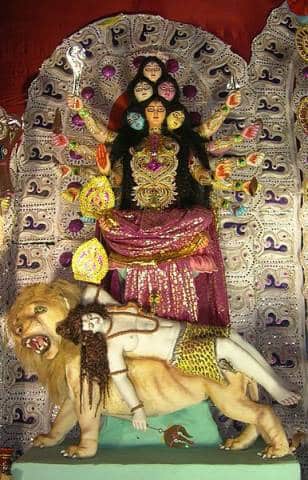
Kamakhya is a goddess of desire. She is worshiped in Kamarupa (Assam). She is one of the 52 Shakti Peethas related to the goddess Parvati. The goddess is worshiped as the power that resides within every woman.
She is venerated as the bleeding goddess as she represents the mythical womb of Shakti. It is said that, in the month of June, she menstruates. And the Brahmaputra River turns red. Her temple is then closed for three days, and sacred water is distributed among devotees.
She is portrayed as a young woman with six heads of different colors. Each head has a third eye, and she is adorned with ornaments. She is the representation of procreation.
As we can see, Hindu goddesses are an important part of mythology as well as religion. They are inspiring in their different roles. They show us how to be independent and confident in our own forms and how to rise above our own potential. Also, they show us how to be responsible for our duties, giving strength to the feminine aspect of everything present in nature. They are calm against the odds and fierce against injustice. They form the foundation of every legend and complete the story of the gods with whom they are associated.
Other Goddesses
We hope you enjoyed this post, do check out some of the other goddesses we also write about. You can find the complete list of goddesses sorted across regions and religions here.

